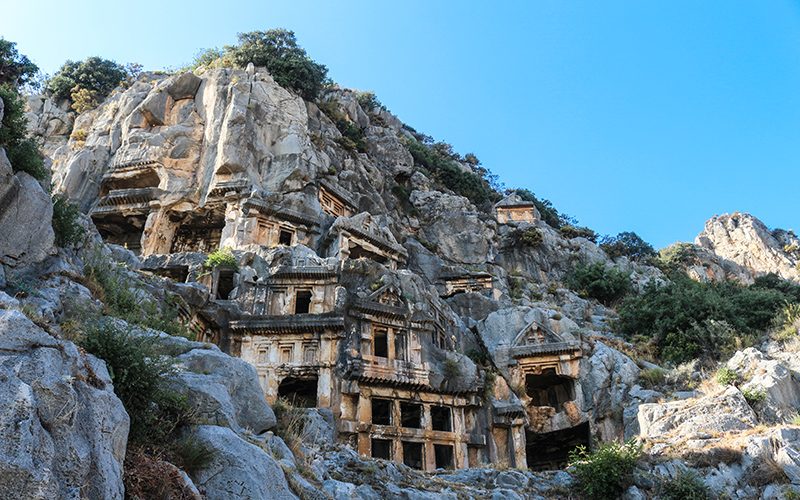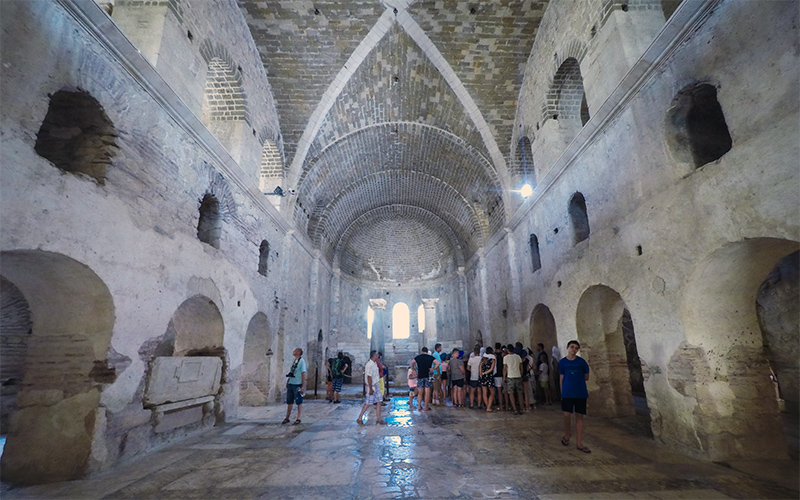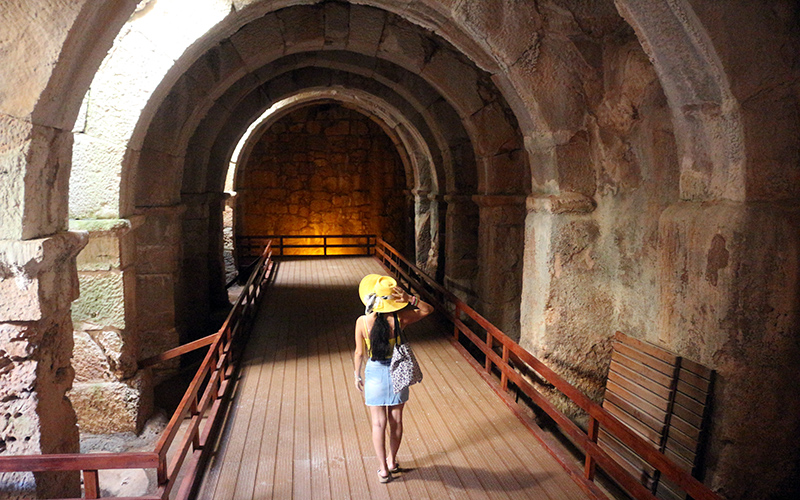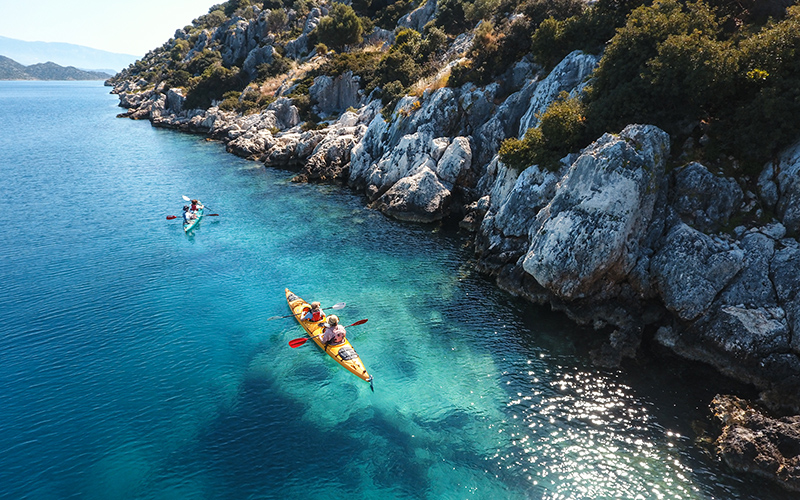Demre, formally known as Kale, is located on the western coast of Antalya. In terms of area, it’s one of the province’s smallest counties. But in terms of the historic importance it possesses, it’s unexpectedly rich and grand. Known as Myra in ancient times, it held great importance during Byzantine times. Although it remains in the shadows of touristic destinations like Kas and Alanya, it’s made itself more known in recent years.
With its historic past, archeologic remains, delicious local cuisine, mild climate, and geographic location, it’s actually a perfect touristic town. Compared to other touristic places, it’s quite quiet. What is there to see in laid-back, peaceful Demre? Here’s all the details.
Places to See in Demre
1. The Ancient City of Myra

The history of the ancient of Myra stretches back to the 5th century BCE. It played an important role during both the Lycian and the Roman Periods. Located in the center of the city of Demre, this ancient city is famous for its rock tombs and ancient theater. It’s one of the six biggest cities in the Lycian Civilization, which developed history’s earliest known federation. Myra is one of the most visited sites in Demre.
Myra progressed quite rapidly during the 2nd century BCE and was furnished with many buildings during that time. Myra grew during the Middle Ages; this is also where St. Nicolas (also known as Santa Claus) served as a bishop. During the 7th century, Myra was greatly damaged by earthquakes, floods, and the silt carried in by the Demre stream. In the 13th century, the silt from the Demre Stream filled the entire plains and served as the beginning to the end of the city’s commercial and social life. Covering just a small area, you can easily visit this ancient city in just 30 minutes.
The Ancient City of Myra is open from 08:30 to 19:00 during the summer season (April 1st to October 31st) and 08:30 to 17:30 in the winter season (November 1st to March 31st). It’s open to visitors seven days a week. The entry fee to Myra is 45 TL and museum passes are accepted.
2. St. Nicolas Church

The Church of St. Nicolas (Santa Claus Museum) is one of the sites in Demre that shouldn’t be missed. The Church was built in honor of St. Nicolas, also known as Santa Claus, who was born in Patara in 243 CE. St. Nicolas is an important name in the world of Orthodox Christianity. He is said to have been born in Patara according to many sources. Winning the fondness of the public with his philanthropy, St. Nicolas is known as the protector of children, sailors, and travelers. St. Nicolas also served as the bishop of Myra.
Excavations of the church now known as the St. Nicholas Museum began in 1989. The mosaics of this church, which was uncovered from meters underground during these excavations, are especially worth seeing. Make sure to also visit the chamber tomb to the south of the church where you’ll find 16 scenes describing St. Nicolas’s life and four holiday scenes.
The St. Nicholas Museum is open from 08:30 to 19:00 during the summer season (April 1st to October 31st) and 08:30 to 17:30 in the winter season (November 1st to March 31st). You cannot enter within 30 minutes of closing time. It’s open to visitors seven days a week. The entry fee is 50 TL and museum passes are accepted.
3. Andriake Museum of Lycian Civilizations

The Andriake Museaum of Lycian Civilizations is another museum that should be added to your list of things to see in Demre. It gets its name from the Ancient City of Andriake on the Demre Stream. The ancient city was used as the harbor of the city of Myra. Located 5 km from the center of Demre, Andriake is positioned to the north and south of an inland harbor where the Myros Stream meets the sea. Home to a natural harbor, this harbor city began an international center of trade during ancient times.
The Museum of Lycian Civilizations was opened to visitors after a long period of restoration. The building once used to store grain, called a ‘granarium’, now serves as the museum building. Traces of the Lycian Civilization are displayed in 6 rooms.
The Museum of Lycian Civilizations is open from 08:30 to 19:00 during the summer season (April 1st to October 31st) and 08:30 to 17:30 in the winter season (November 1st to March 31st). It’s open to visitors seven days a week. The entry fee is 10 TL and museum passes are accepted. You can use the same ticket to visit the city of Andriake.
4. Burguc Suyu Spring

The Burguc Suyu Spring is a natural spring whose water stays ice-cold year-round and contains sodium chloride and magnesium. It’s located 3.5 km from the center of Demre in the direction of Cayagzi, right on the side of the main road. Because of its bad smell it’s also known locally as ‘kokar su’ (meaning smelly water).
Burguc Suyu has been said to cure many illnesses since the Lycian Era. Residents of Demre come here in the morning to drink this water on an empty stomach. Its salt concentration is lower in the morning, but increases in the afternoon. They say it’s good for your digestive system. If you come here in the summer especially, take a dip in this water to cool off. This mineral water is 16.5 degrees Celsius. It’s pretty cold, but worth a try. Entry is free.
5. Kekova Island: The Sunken City of Kekova

Sitting between Kas and Demre, Kekova is a precious place. The region is home to the biggest Mediterranean island in Turkey, Kekova Island, Kalekoy, the Village of Ucagiz, and countless bays. You can reach Kekova with one of the daily boat tours that depart from both Kas and Cayagzi. Although this special stop on the Blue Cruise is typically associated with Kas, it’s actually within the borders of Demre.
The boat tours of Kekova starting from Demre depart in the morning and visit some of the most beautiful bays in the Kekova region. Kalekoy, one of Turkey’s most unique villages, is truly special with its scenic fortress at the top of the hill, terraces of houses, and original architecture.
Ucagiz is another quiet village on the Kekova route. Thanks to its natural, harbor-like structure, it was once an important refuge for sailors. Sitting within the borders of Demre, Ucagiz is worth seeing for its partially submerged sarcophagi, ancient city of Theimussa, and calm water. The connection between this village and the Kekova island was submerged after a violent earthquake.
